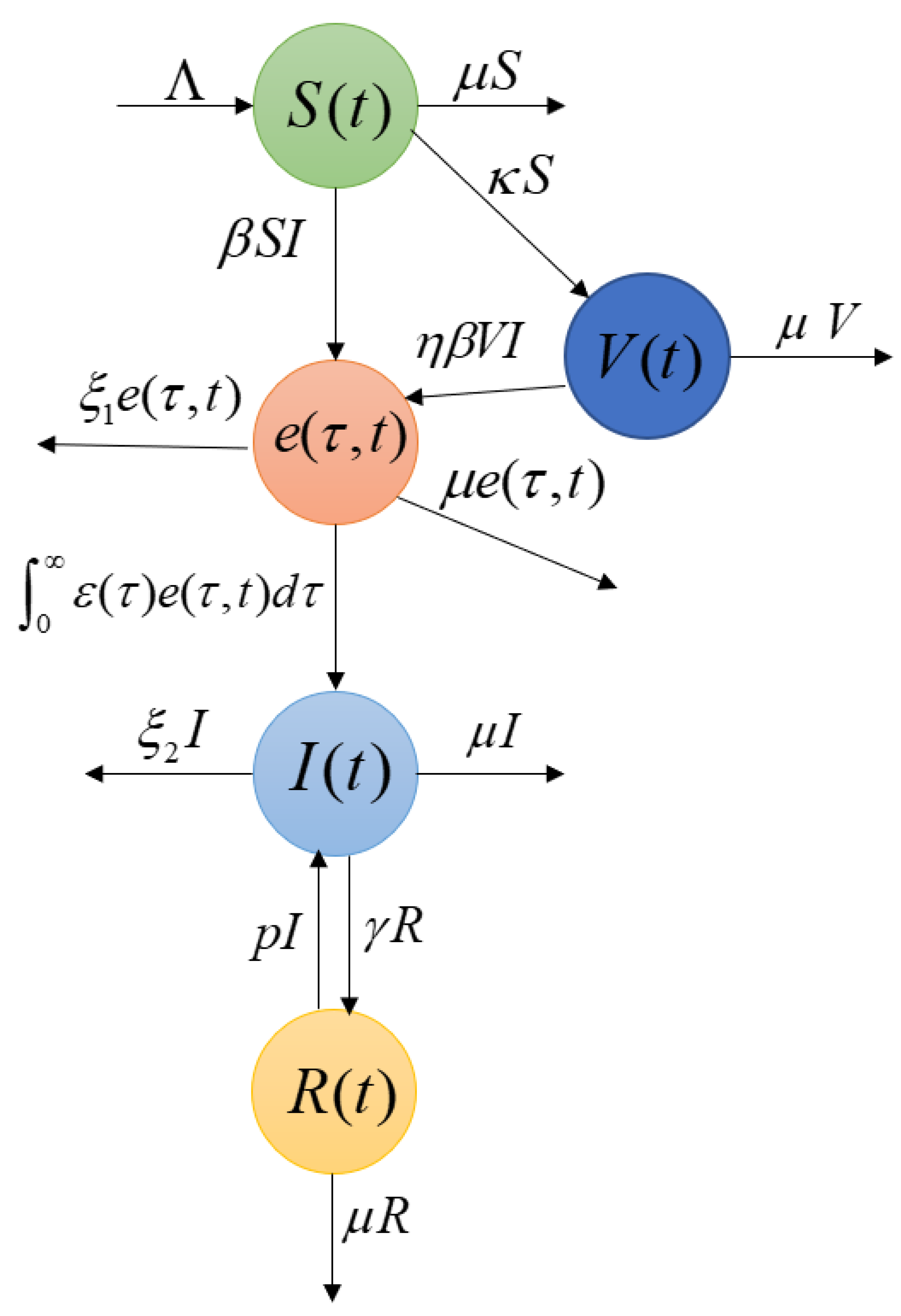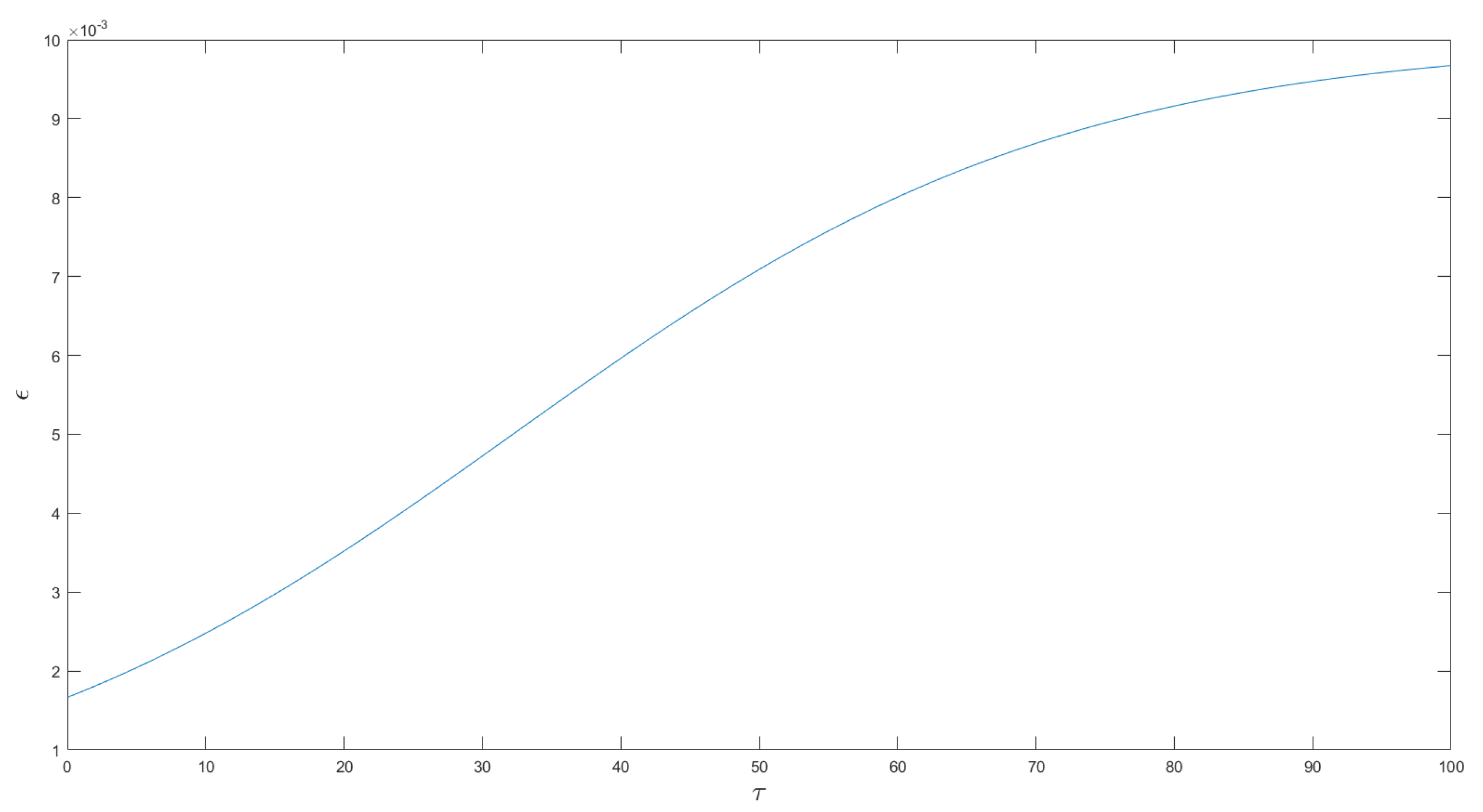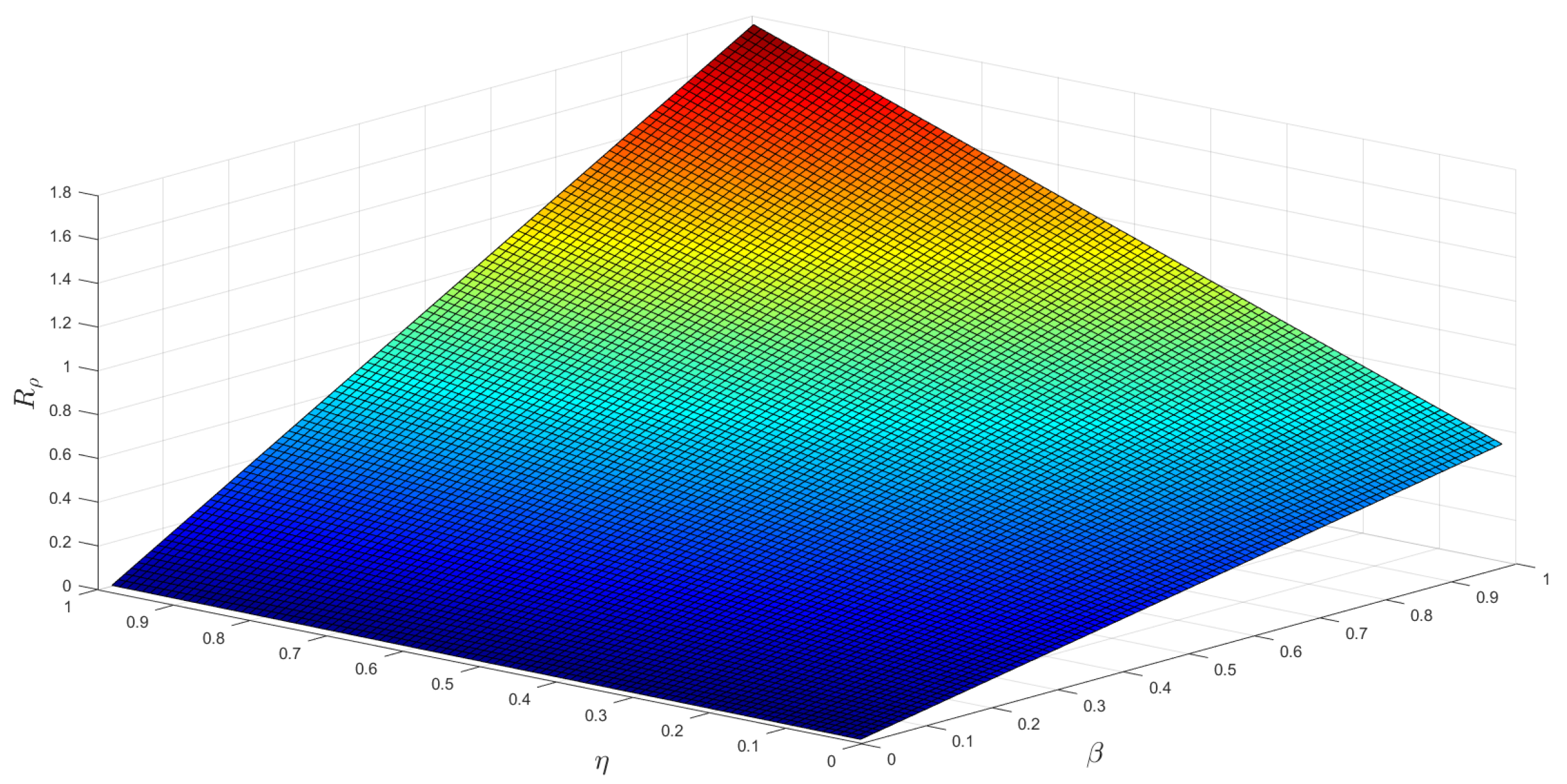Dynamical Analysis of an Age-Structured SVEIR Model with Imperfect Vaccine
Abstract
:1. Introduction
2. Mathematical Model and Existence of Equilibrium Points
2.1. Mathematical Model
2.2. Existence of Equilibrium Points
3. Preliminary Results
3.1. Semi-Flow
- (a)
- and ;
- (b)
- is Lipschitz continuous on , that is, , ;
- (c)
- There is a belonging to such that , .
- (a)
- , for each , we have ;
- (b)
- Ω attracts all points in Σ, and Ψ is point-dissipative.
- (a)
- ;
- (b)
- .
3.2. Asymptotic Smoothness
- (a)
- There is a continuous function such that and , ;
- (b)
- is fully continuous, where t is non-negative;
3.3. Uniform Persistence
4. Stability Analysis of the Equilibrium States
4.1. Global Stability of the Disease-Free Equilibrium State
4.2. Global Stability of the Endemic Equilibrium State
5. Numerical Simulations
6. Conclusions
Author Contributions
Funding
Data Availability Statement
Acknowledgments
Conflicts of Interest
References
- Kermark, W.O.; Mckendrick, A.G. A contribution to the mathematical theory of epidemics. Proc. R. Soc. Lond. Ser. 1927, 115, 700–721. [Google Scholar]
- Li, J.Y.; Yang, Y.L.; Zhou, Y.C. Global stability of an epidemic model with latent stage and vaccination. Nonlinear Anal. Real World Appl. 2011, 12, 2163–2173. [Google Scholar] [CrossRef]
- Wang, J.L.; Huang, G.; Takeuchi, Y.; Liu, S. SVEIR epidemiological model with varying infectivity and distributed delays. Math. Biosci. Eng. 2011, 8, 875–888. [Google Scholar] [PubMed]
- Upadhyay, R.K.; Kumari, S.; Misra, A.K. Modeling the virus dynamics in computer network with SVEIR model and nonlinear incident rate. J. Appl. Math. Comput. 2017, 54, 485–509. [Google Scholar] [CrossRef]
- Zhang, Z.; Kundu, S.; Tripathi, J.P.; Bugalia, S. Stability and Hopf bifurcation analysis of an SVEIR epidemic model with vaccination and multiple time delays. Chaos Solitons Fractals 2020, 131, 109483. [Google Scholar] [CrossRef]
- Castillo-Chavez, C.; Song, B. Dynamical models of tuberculosis and their applications. Math. Biosci. Eng. 2004, 1, 361–404. [Google Scholar] [CrossRef]
- Zou, L.; Ruan, S.G.; Zhang, W.N. An age-structured model for the transmission dynamics of hepatitis B. Siam J. Appl. Math. 2010, 70, 3121–3139. [Google Scholar] [CrossRef] [Green Version]
- Gumel, A.B.; McCluskey, C.C.; Watmough, J. An SVEIR Model for Assessing Potential Impact of an Imperfect Anti-Sars Vaccine. Math. Biosci. Eng. 2006, 3, 485–512. [Google Scholar] [PubMed]
- Gumel, A.B.; McCluskey, C.C.; van den Driessche, P. Mathematical study of a staged progression HIV model with imperfect vaccine. Bull. Math. Biol. 2016, 68, 2105–2128. [Google Scholar] [CrossRef] [PubMed]
- Röst, G. SEIR epidemiological model with varying infectivity and infinite delay. Math. Biosci. Eng. 2008, 5, 389–402. [Google Scholar]
- Griffiths, J.; Lowrie, D.; Williams, J. An age-structured model for the AIDS epidemic. Eur. J. Oper. Res. 2000, 124, 1–14. [Google Scholar] [CrossRef]
- Magal, P.; McCluskey, C.C.; Webb, G.F. Lyapunov functional and global asymptotic stability for an infection-age model. Appl. Anal. 2010, 89, 1109–1140. [Google Scholar] [CrossRef]
- Inaba, H.; Sekine, H. A mathematical model for Chagas disease with infection-age-dependent infectivity. Math. Biosci. 2004, 190, 39–69. [Google Scholar] [CrossRef] [PubMed]
- Ebenman, B. Niche differences between age classes and intraspecific competition in age-structured populations. J. Theor. Biol. 1987, 124, 25–33. [Google Scholar] [CrossRef]
- Guo, Z.K.; Xiang, H.; Huo, H.F. Analysis of an age-structured tuberculosis model with treatment and relapse. J. Math. Biol. 2021, 82, 1–37. [Google Scholar] [CrossRef] [PubMed]
- Xu, R. Global dynamics of an epidemiological model with age of infection and disease relapse. J. Biol. Dyn. 2018, 12, 118–145. [Google Scholar] [CrossRef] [Green Version]
- Browne, C.J.; Plyugin, S.S. Global analysis of age-structured within-host virus model. Discret. Contin. Dyn. Syst. Ser. 2013, 18, 1999–2017. [Google Scholar] [CrossRef]
- Dai, W.H.; Zhang, H.L. Dynamical analysis for an age-structured model of eating disorders. J. Appl. Math. Comput. 2023, 69, 1887–1901. [Google Scholar] [CrossRef]
- Kenne, C.; Mophou, G.; Dorville, R.; Zongo, P. A model for brucellosis disease incorporating age of infection and waning immunity. Mathematics 2022, 10, 670. [Google Scholar] [CrossRef]
- Li, H.; Wang, J. Global dynamics of an SEIR model with the age of infection and vaccination. Mathematics 2021, 9, 2195. [Google Scholar] [CrossRef]
- Wang, Y.P.; Hu, L.; Nie, L.F. Dynamics of a hybrid HIV/AIDS model with age-structured, self-protection and media coverage. Mathematics 2023, 11, 82. [Google Scholar] [CrossRef]
- He, Z.R.; Zhou, N. Controll ability and stabilization of a nonlinear hierarchical age-structured competing system. Electron. J. Differ. Equ. 2020, 2020, 1–16. [Google Scholar]
- Liu, L.L.; Liu, X.N. Global stability of an age-structured SVEIR epidemic model with waning immunity, latency and relapse. Int. J. Biomath. 2017, 10, 1750038. [Google Scholar] [CrossRef]
- Huo, H.F.; Yang, P.; Xiang, H. Dynamics for an SIRS epidemic model with infection age and relapse on a scale-free network. J. Frankl.-Inst.-Eng. Appl. Math. 2019, 356, 7411–7443. [Google Scholar] [CrossRef]
- Khan, A.; Zaman, G. Optimal control strategy of SEIR endemic model with continuous age-structure in the exposed and infectious classes. Optim. Control. Appl. Methods 2018, 39, 1716–1727. [Google Scholar] [CrossRef]
- Diekmann, O.; Heesterbeek, J.A.P.; Metz, J.A. On the definition and the computation of the basic reproduction ratio in models for infectious diseases in heterogeneous populations. J. Math. Biol. 1990, 28, 365–382. [Google Scholar] [CrossRef] [Green Version]
- Hale, J.K. Functional Differential Equations. In Analytic Theory of Differential Equations, Proceedings of the Conference at Western Michigan University, Kalamazoo, MI, USA, 30 April–2 May 1970; Springer: Berlin/Heidelberg, Germany, 1970; pp. 9–22. [Google Scholar]
- Hale, J.K.; Waltman, P. Persistence in infinite-dimensional systems. Siam J. Math. Anal. 1989, 20, 388–395. [Google Scholar] [CrossRef]
- Adams, R.A.; Fournier, J.J. Sobolev Space; Academic Press: New York, NY, USA, 2003; pp. 38–40. [Google Scholar]
- McCluskey, C.C. Global stability for an SEI epidemiological model with continuous age-structure in the exposed and infectious classes. Math. Biosci. Eng. 2005, 9, 819–841. [Google Scholar]
- Magal, P. Compact attractors for time-periodic age-structured population models. Electron. J. Differ. Equ. 2001, 2001, 1–35. [Google Scholar]
- Magal, P. Global attractors and steady states for uniformly persistent dynamical systems. Siam J. Math. Anal. 2005, 37, 251–275. [Google Scholar] [CrossRef] [Green Version]



Disclaimer/Publisher’s Note: The statements, opinions and data contained in all publications are solely those of the individual author(s) and contributor(s) and not of MDPI and/or the editor(s). MDPI and/or the editor(s) disclaim responsibility for any injury to people or property resulting from any ideas, methods, instructions or products referred to in the content. |
© 2023 by the authors. Licensee MDPI, Basel, Switzerland. This article is an open access article distributed under the terms and conditions of the Creative Commons Attribution (CC BY) license (https://creativecommons.org/licenses/by/4.0/).
Share and Cite
Wang, Y.; Zhang, H. Dynamical Analysis of an Age-Structured SVEIR Model with Imperfect Vaccine. Mathematics 2023, 11, 3526. https://doi.org/10.3390/math11163526
Wang Y, Zhang H. Dynamical Analysis of an Age-Structured SVEIR Model with Imperfect Vaccine. Mathematics. 2023; 11(16):3526. https://doi.org/10.3390/math11163526
Chicago/Turabian StyleWang, Yanshu, and Hailiang Zhang. 2023. "Dynamical Analysis of an Age-Structured SVEIR Model with Imperfect Vaccine" Mathematics 11, no. 16: 3526. https://doi.org/10.3390/math11163526
APA StyleWang, Y., & Zhang, H. (2023). Dynamical Analysis of an Age-Structured SVEIR Model with Imperfect Vaccine. Mathematics, 11(16), 3526. https://doi.org/10.3390/math11163526




